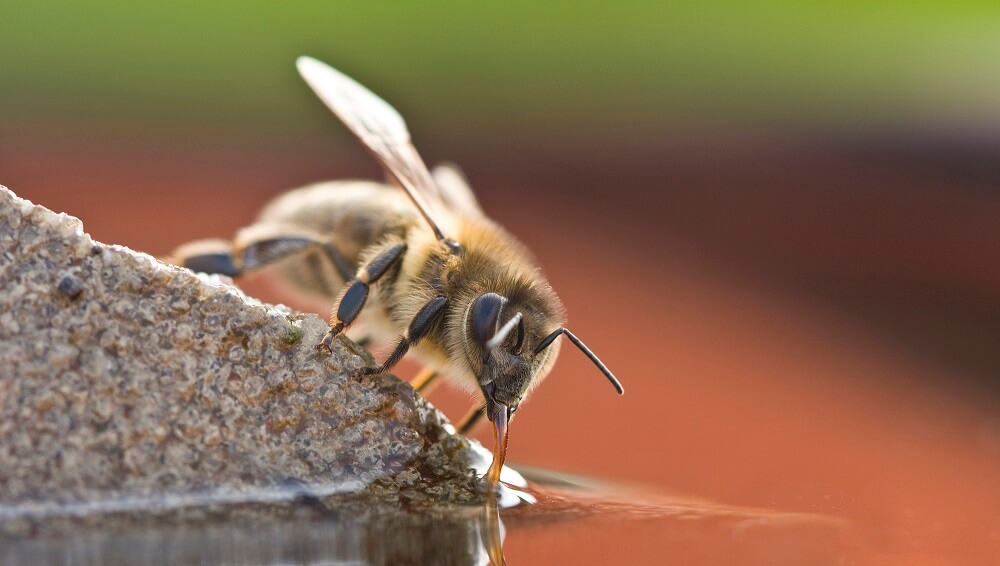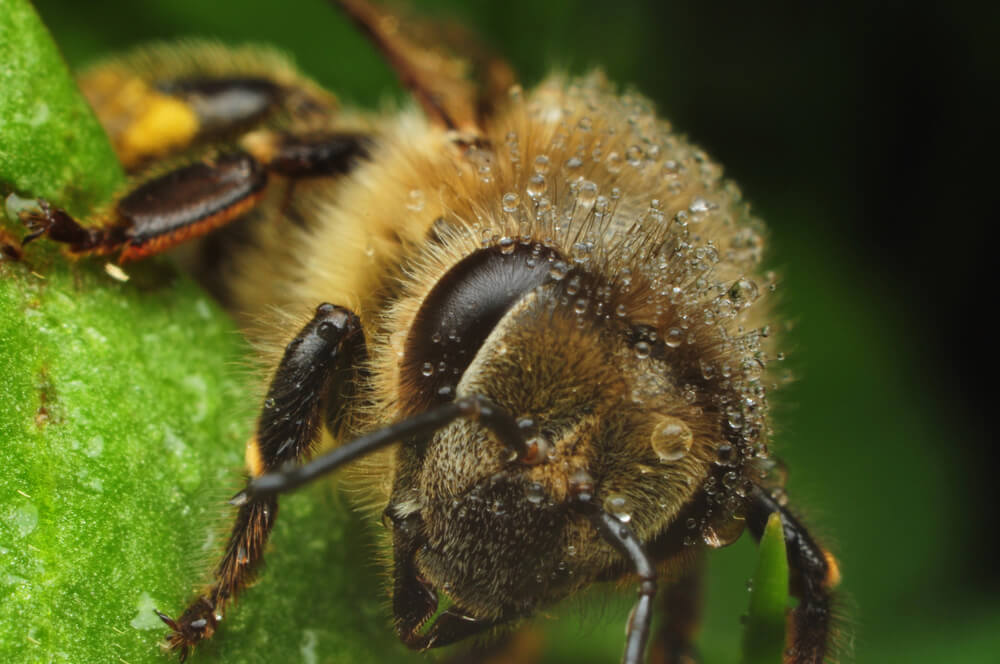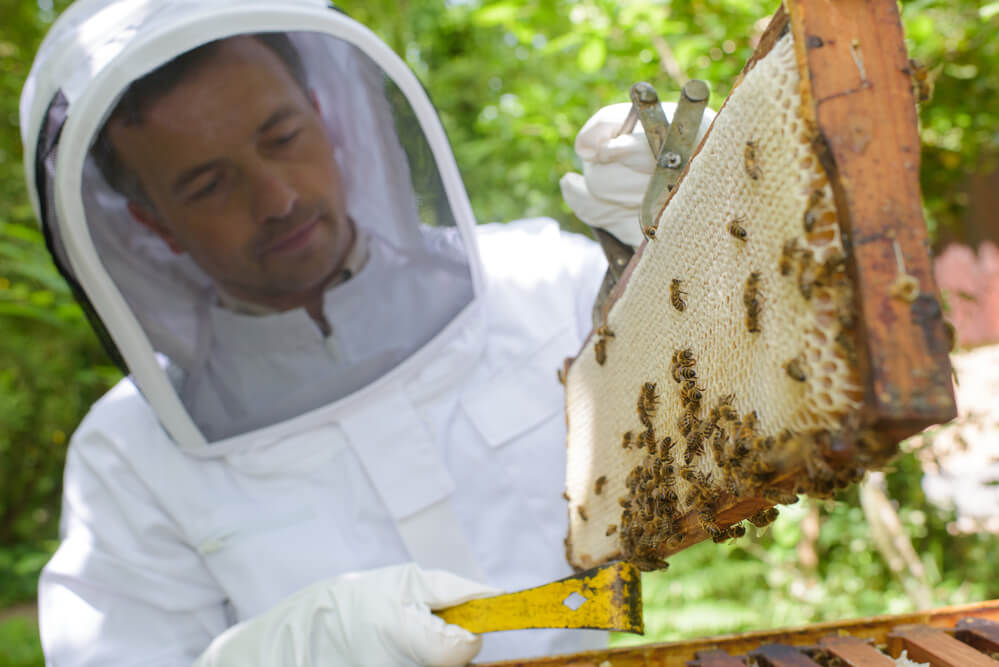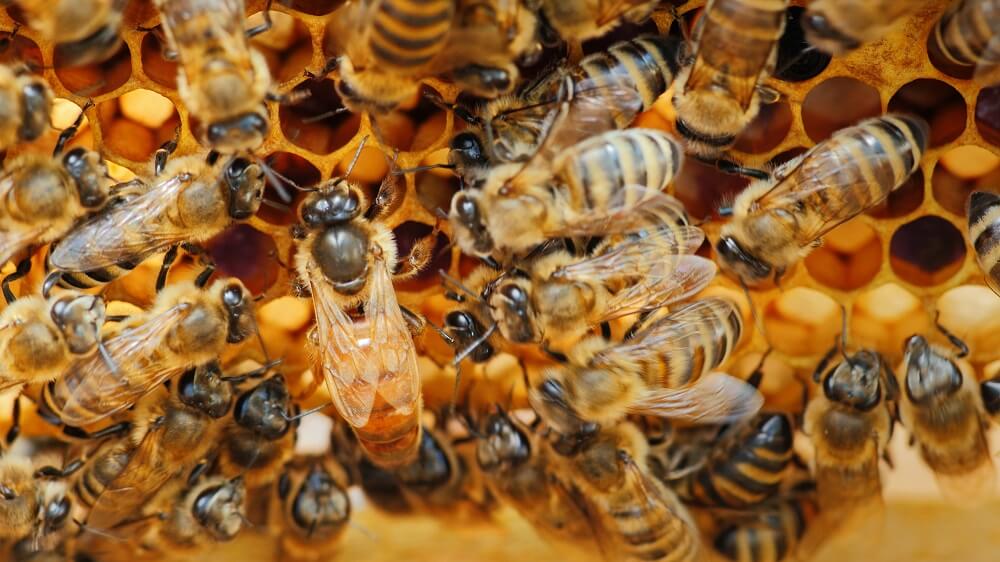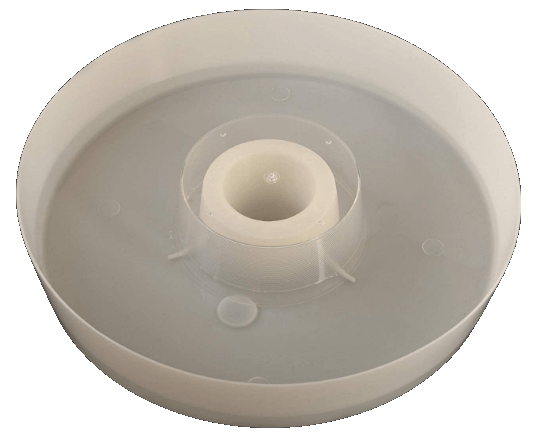Let’s face it.
As a beekeeper, you have tons of questions about maintaining a healthy and happy hive.
And guess what?
You’re not alone.
So that leads us to the million-dollar question:
How do I make sugar water for bees?
I’m glad you asked.
Why?
Because sugar water can help boost the strength of your colony in the early spring or prepare them for winter. Both of these things can keep your colony alive and promote a healthy bee population.
So are you ready for the sugar water recipe?
Let’s jump in.
2 Ratios to Use When Making Sugar Water for Bees
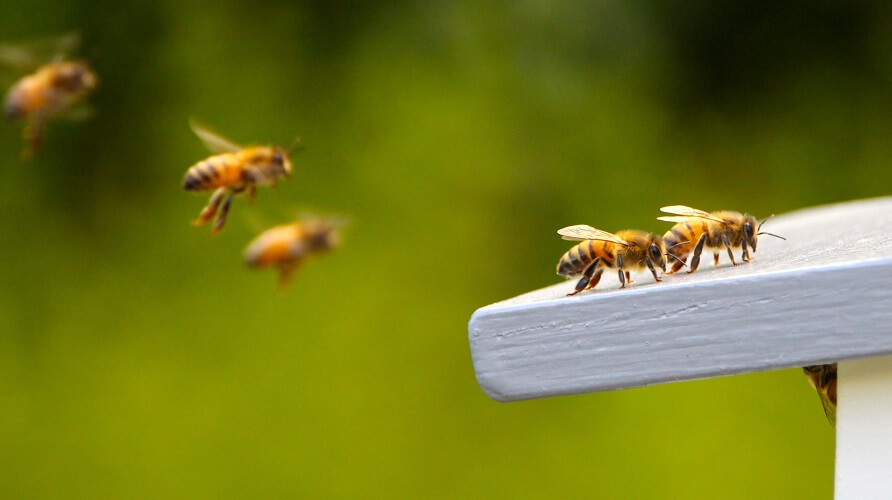
There are two recipes for sugar water:
- 1:1 sugar water
- 2:1 sugar water
What’s the difference?
Simple.
In the spring, you’ll feed bees 1:1 sugar water (one part sugar to one part water). This helps new or weak hives get established and promotes brood rearing.
In the fall, you’ll feed bees 2:1 sugar water (two parts sugar to one part water). This will help them survive the winter.
That’s it in a nutshell.
But there are a few more things you should know first.
So let’s talk more specifically about both of these sugar water recipes.
1. Sugar Water for Bees in Spring

- Regular white sugar
- Water
- A bee feeder
Remember, your spring sugar-water mixture is 1:1, which is one part sugar to one part water.
To make this recipe, heat one cup of sugar with one cup of water on the stove over medium heat. Heat the sugar water just enough until all the sugar dissolves.
There’s no need to boil this mixture.
After that, allow the sugar water to cool to room temperature before adding it to your bee feeders.
And keep in mind:
When making sugar water for bees, never use brown sugar or molasses because it can make your colonies sick and kill them. Only use regular white sugar.
2. Sugar Water for Bees in Fall
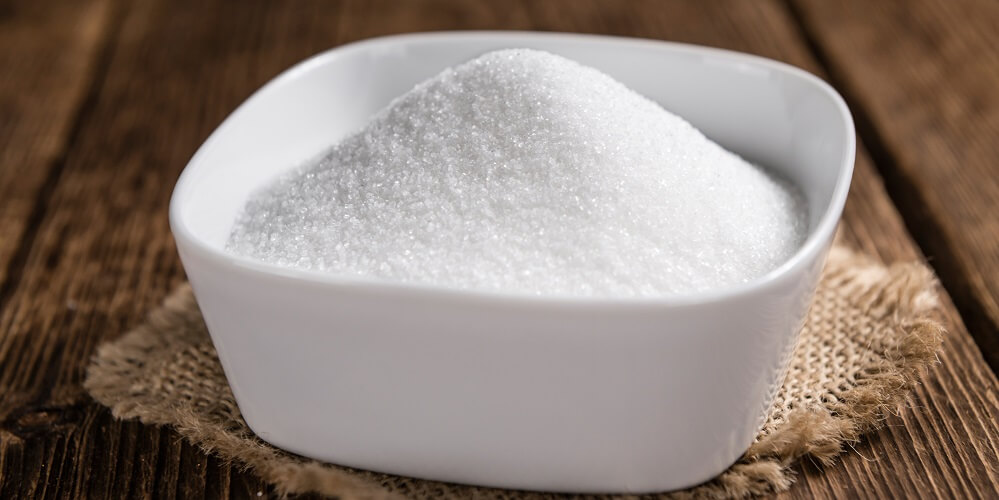
- Regular white sugar
- Water
- A bee feeder
For the fall, your sugar-water ratio will be 2:1.
For example, mix two cups of sugar with one cup of water. Heat on the stove over medium heat until the sugar dissolves.
Don’t forget:
Only use white sugar. Never use brown sugar or molasses as it can hurt your bees.
Since this mixture contains more sugar than water, it’ll have a syrup-like texture. This will help your bees store up food for the winter.
And lastly, allow the sugar water to cool before pouring it into your bee feeders.
When to Stop Feeding Your Bees Sugar Water
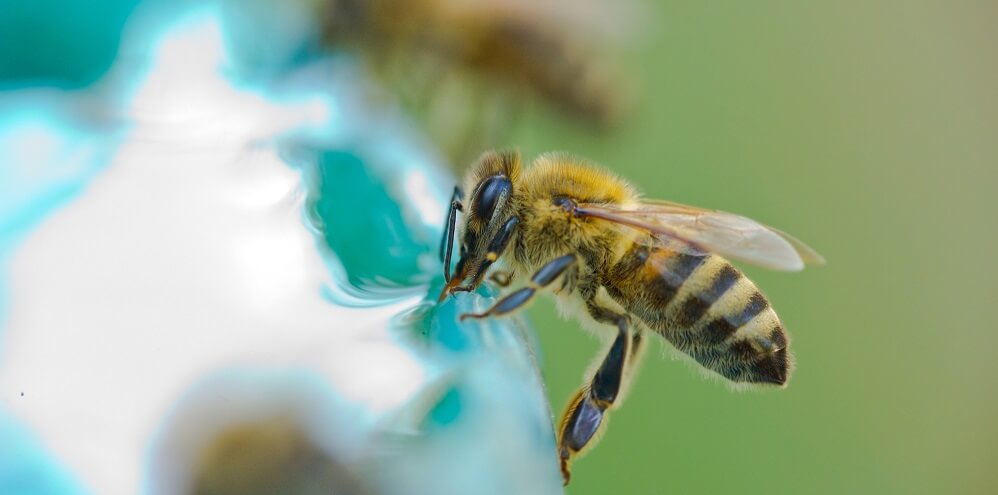
Let’s take this a step further.
You’re probably wondering:
How long do you give bees sugar water?
Good question. There are times when you should and shouldn’t be feeding your bees sugar water.
But let me just say this.
A common mistake new beekeepers make is not feeding their new or weak colonies long enough.
Here’s the thing:
Hives are especially hungry in the early spring because they’ve just come out of winter. And while it’s true that nectar will become more available as flowers bloom in the spring, this doesn’t mean you should stop feeding your bees.
Do this instead:
Wait until the colony has created combs and started filling them with honey.
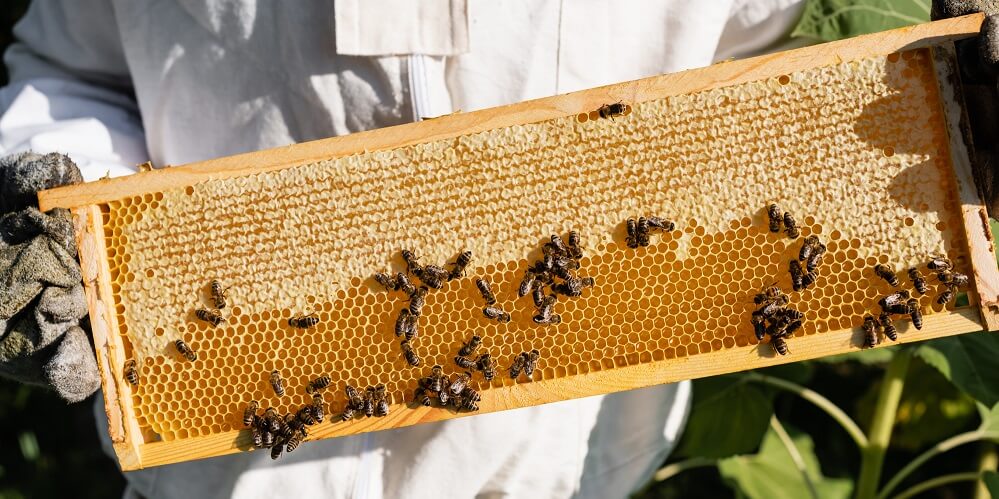
As you do your hive inspections, you can check how much honey is being produced. When your bees have enough comb in the frames and honey stored for the winter, you can stop feeding them sugar water.
For new hives, it can take several months or longer to get established.
But now this is important:
Don’t feed your bees sugar water when you have honey supers on your hive.
Remember, a honey super is a box placed on a hive with frames of comb. It’s what you use to collect honey from your hive.
Then, you’ll use a honey extractor to harvest that honey. Or if you have a flow hive, you can pour the honey straight from the hive into a jar.
That said, bees can’t turn sugar water into honey, so you’ll end up with sugary syrup instead of pure honey if you collect it.
But don’t get me wrong:
Sugar water is completely safe for your bees, even if it doesn’t make honey. You just don’t want to collect sugar water for human consumption because you want real honey, not capped syrup.
Also, making sugar water for bees in the winter won’t garner much attention from your hive. Instead, bees eat their own honey or prefer candy boards because of their high sugar content.
Lastly, it’s important to remember that sugar only offers half of the dietary requirements for bees. They also need pollen and regular water.
Providing your bees with pollen patties in the spring helps. Also, keeping a safe supply of water for your bees all year long is best. Try using one of these bee waterers to get you started.
So in summary, your bees need three things:
- Sugar water
- Regular water (all year round)
- Pollen patties (in the spring)
4 Feeders to Use When Making Sugar Water for Bees
If you’re a beekeeper who wants to feed your hive, click here.
If you just want to feed your local bees, click here.
If you want to learn about both methods, then keep reading…
1. Top feeder
A top feeder sits on top of the upper box and under the outer cover.
Example:
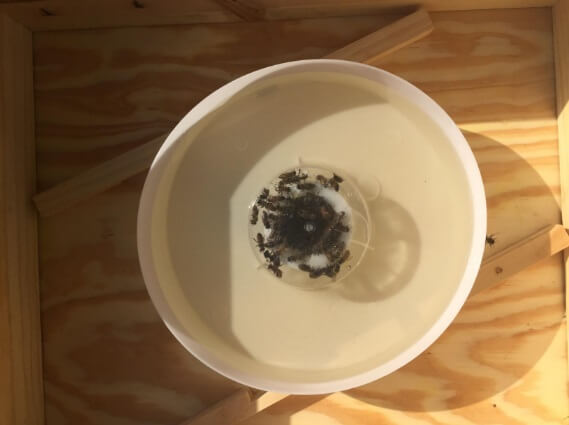
Top feeders are a favorite amongst beekeepers because they’re easy to set up and clean. You also don’t have to disturb the hive to refill it with sugar water.
More importantly?
Since this feeder is placed inside the hive, it helps deter robbing from other colonies. Outside feeders are easily accessible to other colonies, so they may invade and steal the sugar water.
But the top feeder helps protect against this robbing behavior.
Here’s a top feeder in action:
And here’s a good tip:
When refilling your top feeder, make sure there are no bees in the main reservoir. This prevents you from accidentally drowning a bee that got stuck.
Pros:
- Easy to refill
- It doesn’t disturb the colony
- Deters robbing from other colonies
- It can hold a decent amount of bee food
2. Frame feeders
A frame feeder holds sugar water and replaces one frame in the hive body.
Like this:
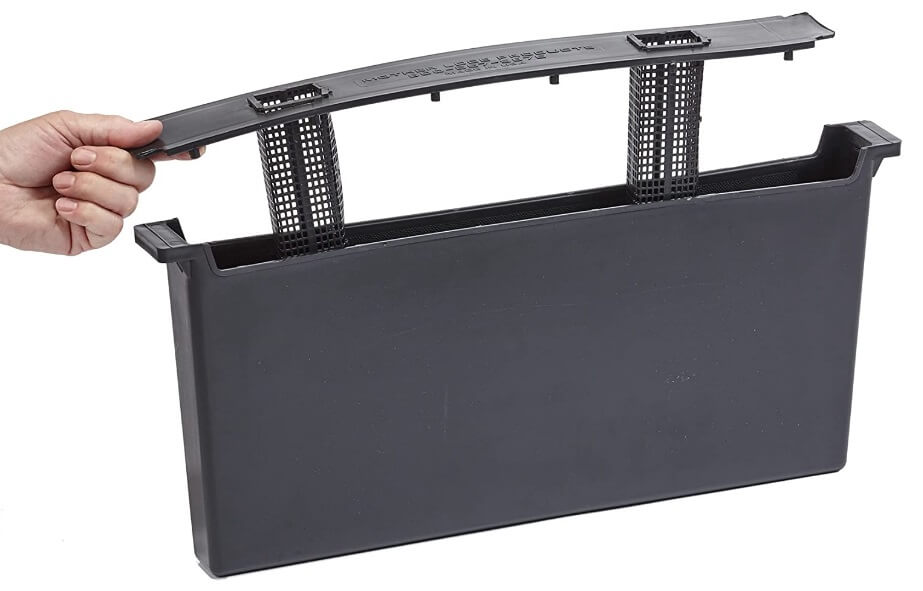
So if the hive holds ten frames, you’ll use one feeder frame and nine regular frames.
What I love about this frame feeder is that there are steps for the bees to climb in safely without drowning.
That said, I recommend cutting up a few wine corks and placing them in the frame feeder. These floating corks give the bees an extra access point to crawl on if they slip in.
Here’s a video of a frame feeder in use:
That said, always make sure to have your bee suit on and bee smoker ready when inspecting your hive.
Pros:
- Bees can easily access the food
- Not prone to leaking or spilling
- Less worry about intruders stealing the food
Cons:
- You’re disrupting the hive when you refill the frame with sugar water
- You might potentially lose some bees to drowning
3. Entrance Feeder
This is the most common feeder you’ll find in backyard beekeeping kits. This feeder is placed outside the entrance of the hive.
Take a look:
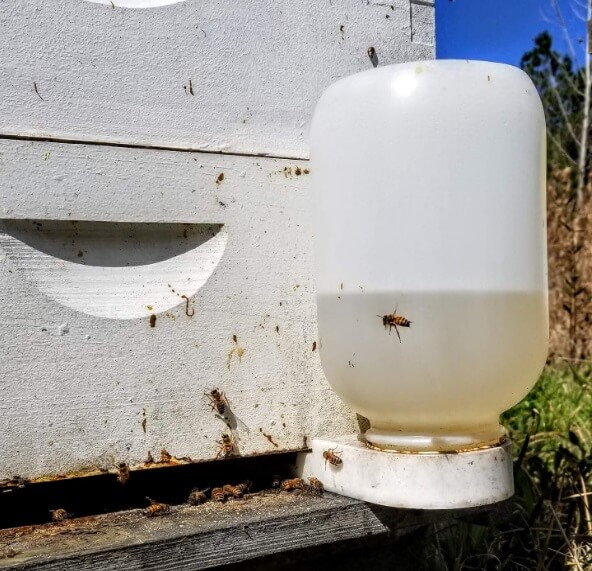
It’s typically an upside-down jar with holes in the lid. The sugar water then drips into the base of the feeder.
Since the entrance feeder is visible outside the hive, you can easily see when it needs refilling.
The only problem?
Sugar water hanging on the front of the hive can lead to robbing from other hungry colonies. That’s why many beekeepers place these feeders inside the hive to prevent robbing.
It’s also why I don’t recommend entrance feeders if you’re using them right outside the hive.
It’s like putting a big red target on your bees and inviting robbers in.
Pros:
- Easy to refill
- Non-disruptive to the hive
Cons:
- It can attract robbers to your hive
4. Open Feeder
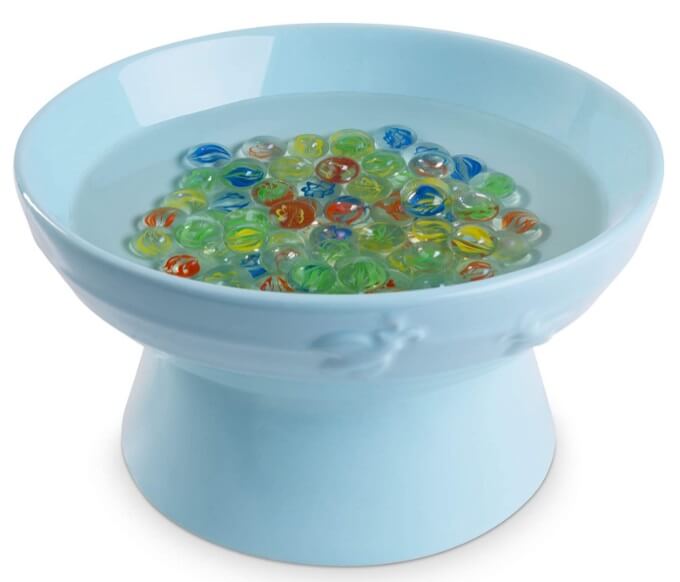
You can use this type of feeder whether you’re a beekeeper or not.
Because here’s the thing:
It’s nice to have an open feeder around for your local bees. This includes honeybees, bumblebees, and other types of solitary bees.
With that in mind, if your local bees are getting plenty of nectar from plants, they’ll ignore the open feeder.
And that’s perfectly okay.
It just means there are plenty of natural flowers available to the bees.
Now there’s one important note about open feeders:
Bees can’t swim, so you need to give them something to land on while they drink. Marbles, rocks, or crystals work well as landing perches.
You’ll want to place your marbles, rocks, or crystals in a bowl, birdbath, or bee feeder. Then fill the feeder with sugar water. Make sure the sugar water line falls below the marbles, rocks, or crystals.
Check it out:
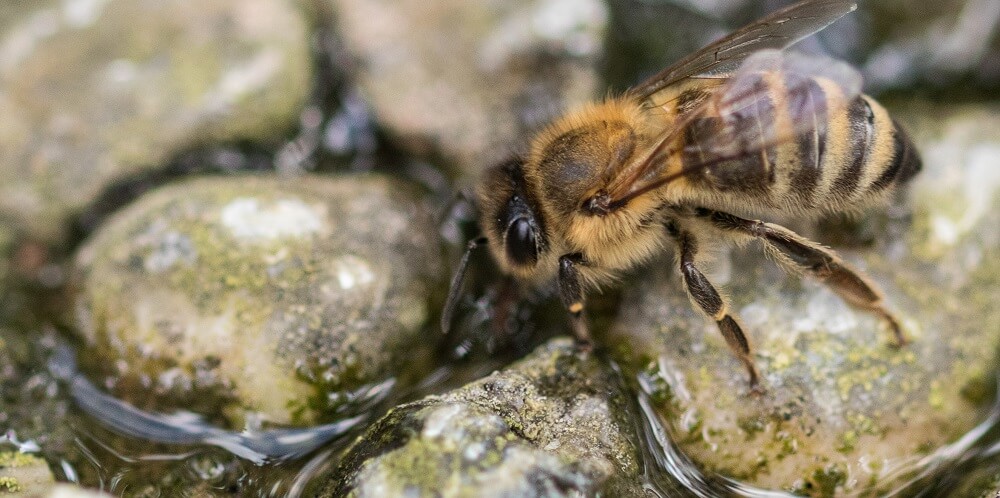
If you’re using open feeders as a beekeeper, place them 60-100 feet away from your hive. Putting them too close to your hive can entice robbing behavior.
Also, you can use an open feeder as a bee waterer. Again, just make sure you give your bees safe landing perches for the regular water.
Pros:
- Easy to refill
- Provides plenty of sugar water
Cons:
- It can cause drowning if you don’t use landing perches
- Bees can’t get the food in bad weather
- It can cause robbing if you put these feeders near your hive
FAQs about Sugar Water for Bees
- Why should I give bees sugar water, anyway?
- How long will sugar water for bees last?
- Does feeding bees sugar water make them lazy?
- How do I make a gallon of sugar water for bees?
- When should I start feeding bees sugar water?
- When should I stop feeding bees sugar water?
- How do I stop or prevent robbing when feeding bees?
- How do I prevent bees from drowning?
- Should you boil the sugar water for bees?
- How do I attract bees to my sugar water?
- How much sugar water does a bee drink daily?
- Should I add honey to my sugar water for bees?
- Is there an alternative to sugar water for bees?
- Which sugar is best for bees?
- Can bees turn sugar water into honey?
Why should I give bees sugar water, anyway?
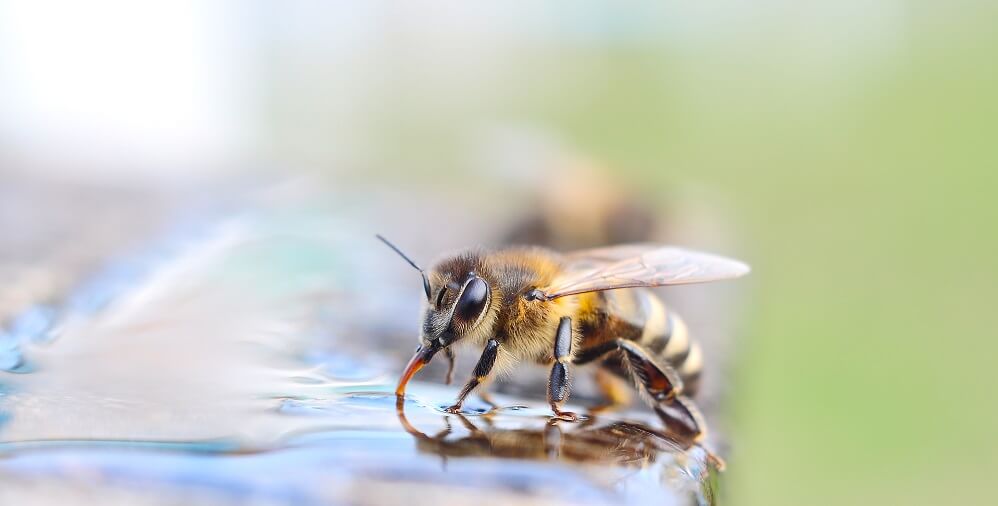
I’ll shoot straight with you.
The best way to feed bees is to plant the best flowers for bees. Sugar water is full of empty carbs.
Nectar, on the other hand, contains vitamins and amino acids that help bees.
Think of it like this:
For bees, nectar is like eating a healthy home-cooked meal.
Sugar water is like eating a frozen dinner. It’ll get the job done and satisfy your cravings, but it’s not exactly the healthiest.
So why should you feed sugar water to bees then?
Because many bees – especially new or weak colonies – need an extra boost to survive. Plus, there aren’t always good nectar sources available. So it’s either drink sugar water or starve.
But don’t worry.
Feeding your bees sugar water won’t make them lazy. If there are plenty of nectar sources available from blooming flowers, the bees won’t touch your sugar water.
And that’s a good thing.
Bees prefer to get their food from natural sources.
But, the point of sugar water is to provide them with food when none is available. This can go a long way in helping your hive get established or even helping local bees.
Related: What Does a Queen Bee Look Like?
—> Go back to the FAQs about sugar water for bees
How long will sugar water for bees last?
In my experience, sugar water is highly fermentable in hot climates. This means it can go bad in a matter of 3-4 days which is why I recommend checking on it at least twice per week.
During cooler months, sugar water (2:1 ratio) can last several weeks.
In both cases, you want to change your sugar water before it goes bad. Here are a few ways to tell if your sugar water has expired:
- It has a cloudy or milky color
- Black specks or debris are floating in the water
- It has a strong odor that smells overly sweet, sour, or moldy
- You’re noticing mold or fungus growth inside the feeder
—> Go back to the FAQs about sugar water for bees
Does feeding bees sugar water make them lazy?
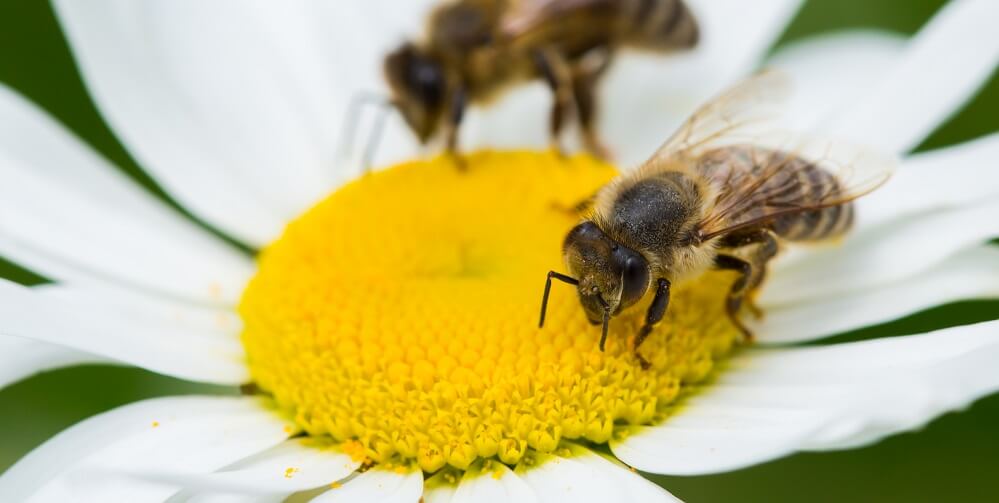
No.
You can call bees many things, but lazy isn’t one of them.
Here’s why:
Bees will choose natural nectar sources from flowers over sugar water any day. Bees will only drink sugar water if there aren’t enough natural nectar sources available.
So if you’re asking yourself, “Should I give bees sugar water?”
The answer is yes. Providing sugar water for bees can help colonies survive. This is especially true for new or weak colonies.
The exception is don’t feed bees sugar water if you have honey supers on the hive. The bees will cap the sugar water, and it won’t be considered pure honey.
Last but not least:
It doesn’t hurt to plant the best flowers for bees that are rich in nectar and pollen. Your bees will thank you.
—> Go back to the FAQs about sugar water for bees
How do I make a gallon of sugar water for bees?
Thankfully, learning how to make a gallon of sugar water for bees is simple. Here are the recipes for both spring and fall:
A gallon of sugar water recipe for spring (1:1 ratio)
- 10 2/3 cups of regular white sugar
- 10 2/3 cups of hot water
A gallon of sugar water recipe for fall (2:1 ratio)
- 16 ¼ cups of regular white sugar
- 8 cups of hot water
You might have to heat your sugar water on the stove over medium heat to get the sugar to dissolve. This only takes a few minutes and boiling isn’t necessary.
Let the sugar water cool to room temperature before feeding it to your bees.
Related: How Many Bees are in a Hive?
—> Go back to the FAQs about sugar water for bees
When should I start feeding bees sugar water?
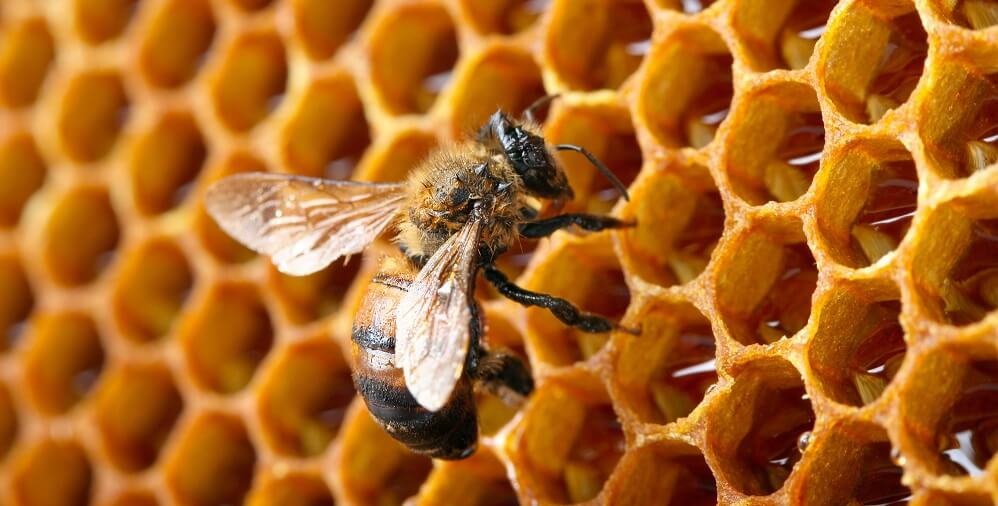
Begin feeding a new colony in the spring immediately. Give the bees a 1:1 mixture of white sugar and water. This will help them get established and promote brood rearing.
If you’re feeding local bees, start in the early spring. This is a crucial time for feeding since many flowers aren’t blooming yet, and bees are hungry after winter.
You might even continue with the sugar water for bees in the summer if natural nectar sources take a dip. This can happen especially in hot, humid climates that go a few weeks without rain.
Now you might be asking:
When should I give my bees 2:1 sugar water?
Give your bees 2:1 sugar water in the fall. This allows them to prepare for winter.
—> Go back to the FAQs about sugar water for bees
When should I stop feeding bees sugar water?
If you’re a beekeeper, you should stop feeding your bees when there are enough combs in the frames and honey stored.
And here’s a rule of thumb:
You should stop feeding your bees sugar water when your honey supers are in place.
A honey super is a box placed on the hive with frames of comb to collect honey. Beekeepers put their honey supers on the hives so the bees will store honey in them. Then the honey will be harvested for human consumption.
If you’re making sugar water for bees while the honey supers are in place, then the bees will store the sugar syrup in the honey supers. Then when you go to harvest your honey, it’ll be contaminated with sugar syrup.
Not good.
You want real, pure honey. Not sugar syrup.
But remember:
Sugar water isn’t harmful to bees. You just don’t want to extract it and label it as “pure honey.”
With that said, if a colony is strong enough to get a honey super, then they likely don’t need sugar water in the first place. They are strong enough to collect everything they need and then some.
—> Go back to the FAQs about sugar water for bees
How do I stop or prevent robbing when feeding bees?
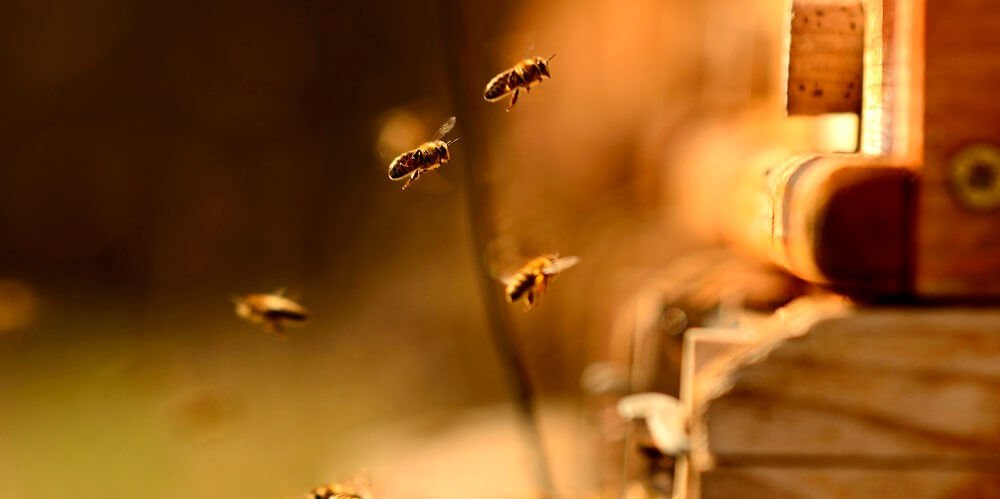
Here’s a brutal truth about beekeeping:
You have to stop or prevent robbing, or you might lose your entire colony.
But here’s the thing:
Robbing happens mostly during a nectar dearth.
A nectar dearth occurs when there is a shortage of nectar-producing flowers. This is common in hot and humid climates that have gone a few weeks without rain. It’s a hard time for all bee colonies.
With that in mind, here are a few ways to stop robbing:
1. Close Off Your Entrance
This is your first line of defense against robbing.
You need to keep as many intruders out as possible. Restricting the entrance of your hive works because your bees can better defend a small opening than a large one.
Many beekeepers place grass or leaves along the entrance to reduce it. This technique is smart because it keeps robbers out yet allows airflow in. Also, the native bees can easily push it out of the way when they no longer need it.
2. Apply Vicks Vapor Rub to the Entrance
Applying Vicks vapor rub on the entrance masks the scent of the hive and confuses the robber bees.
But don’t worry.
Your native bees won’t suffer this same confusion that the robber bees get. They’ll still be able to make their way into their hive.
3. Drape a Wet Towel Over the Hive
Make sure the wet towel extends over the entrance. Or you can toss a large, damp bed sheet over the hive too.
Both techniques discourage robber bees, but your native bees who live there will still enter and exit their hive.
4. Move the hive
There are a few key points to remember when moving a hive. Watch this video first:
Ideally, you want to move the hive as far away from its current location as possible. Some beekeepers will move it as far as two miles away if they can.
If you’re using a horizontal hive, you’ll need a few people to help since it’s longer.
After moving the hive, place a bowl of sugar water in the old hives location. This allows the robber bees to think the robbery is still happening. They’ll continue to take the sugar water until every drop is gone.
More importantly?
The sugar water will take their attention away from the hive you moved.
And as always, make sure you’re wearing protection like a bee suit while you’re handling your hive.
—> Go back to the FAQs about sugar water for bees
How do I prevent bees from drowning?
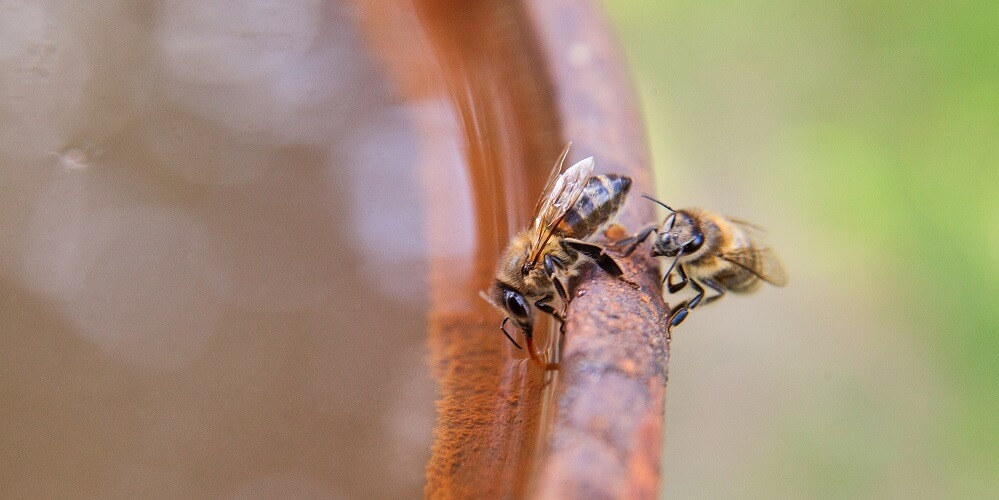
Giving bees landing perches is the best method. This includes putting things like rocks, marbles, or crystals in your sugar water.
If you’re using a frame feeder, you can also cut up wine corks and place them inside. This gives bees a safe space to crawl on if they fall into the sugar water.
—> Go back to the FAQs about sugar water for bees
Should you boil the sugar water for bees?
“Should you boil sugar water and feed it to bees?” is a common question.
Here’s the deal:
Boiling your sugar water isn’t necessary. You typically can dissolve a 1:1 sugar water mixture with hot tap water.
With a 2:1 mixture, place it over the stove on medium heat, occasionally stirring until the sugar dissolves.
—> Go back to the FAQs about sugar water for bees
How do I attract bees to my sugar water?
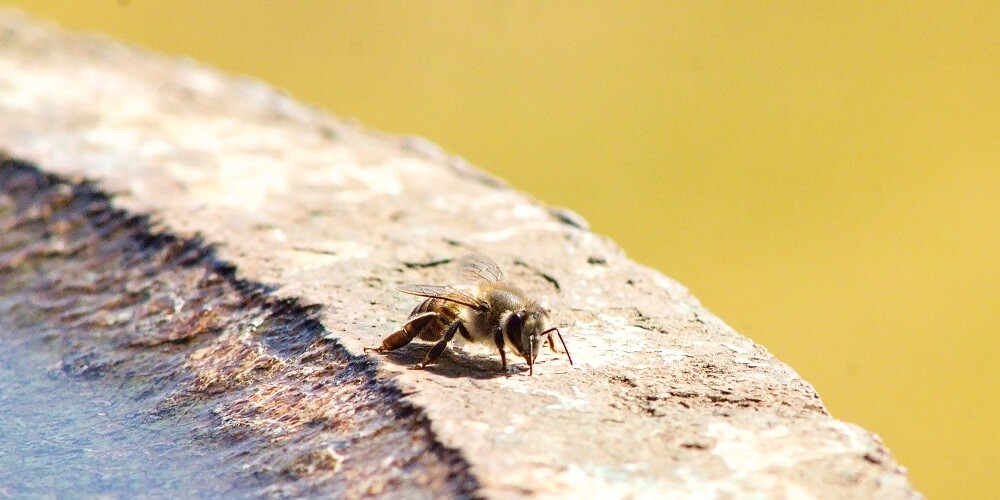
A few drops of lemongrass oil will help get your bees attention. They’re drawn to the scent. Plus, lemongrass oil has antiviral and antifungal properties.
That said, if you’re placing sugar water inside your hive, then you can skip the lemongrass oil.
Why?
Because the bees can easily find the sugar water when it’s placed inside the hive. Plus, lemongrass oil can attract robber bees because of its smell.
If you’re feeding local bees, feel free to add a few drops of lemongrass oil to your sugar water. Place your bee feeder in your garden or yard away from your porch, garage, or entrance of your home. You don’t want a bunch of bees flying around your home entrance.
—> Go back to the FAQs about sugar water for bees
More to Explore:
How much sugar water does a bee drink daily?
The answer?
It depends.
If there are plenty of nectar-producing flowers available, then the bees won’t touch the sugar water.
But if there aren’t enough flowers in your area, then the bees will choose the sugar water so they don’t starve. I’ve seen colonies consume up to a quart of sugar water per day.
Here’s the thing:
Nectar provides bees with their source of carbohydrates. You want bees to get those carbs from natural sources as much as possible.
But like I’ve said:
Sugar water has its place in the backyard beekeeping community. It can help new colonies get established or promote storage for the winter. That’s why it’s important to learn how to feed honeybees sugar water.
—> Go back to the FAQs about sugar water for bees
More to Explore:
Should I add honey to my sugar water for bees?
No.
Feeding your bees honey (that isn’t from their own hive) can put them in danger of catching viruses, spores, and bacteria.
Just stick to sugar water.
Or better yet?
Plant the best flowers for bees that bloom at various times throughout the year.
—> Go back to the FAQs about sugar water for bees
More to Explore:
Is there an alternative to sugar water for bees?

Yes, the preferred way to feed bees is actually through planting the best flowers for bees.
And guess what?
It’s easier than you might think.
There are several flowers on this list that are easy to grow and low maintenance. And once you see your bees buzzing around with excitement, you’ll be glad you planted them.
—> Go back to the FAQs about sugar water for bees
More to Explore:
Which sugar is best for bees?
Only use white sugar. Never use brown sugar or molasses because it isn’t easily digestible and can make your bees sick.
—> Go back to the FAQs about sugar water for bees
More to Explore:
Can bees turn sugar water into honey?
No. No matter what the bees do, it will always just be sugar dissolved in water.
Chemical compounds found in nectar are what produce honey. So since sugar water didn’t come from nectar, it’s not honey.
This is why beekeepers don’t feed their bees sugar water while honey supers are being used. If the sugar water is being collected by the bees, then the honey gets contaminated with sugar water.
The bottom line?
You can’t market honey mixed with sugar water as “pure honey.”
